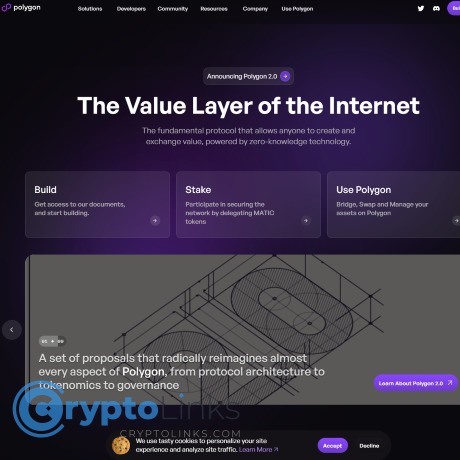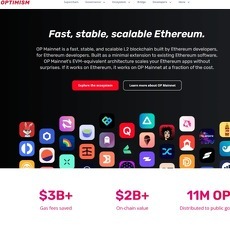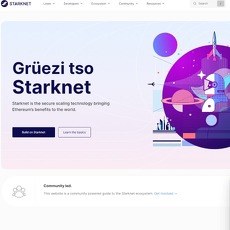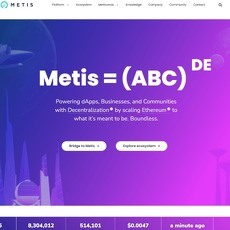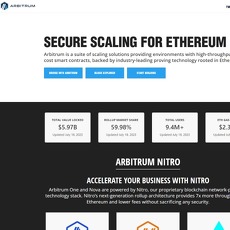Polygon Review
Polygon
polygon.technology
Unraveling the Polygon (MATIC) Project: Revolutionizing the Crypto Space
Today, I'm diving into the fascinating world of Polygon (MATIC), a project that has been creating quite the buzz in the blockchain community. As someone deeply passionate about the crypto space, I've been keenly observing Polygon's progress and its potential impact on the industry. In this review, we'll explore what Polygon is all about, its unique features, and how it stands out amidst a sea of blockchain solutions. So, let's strap on our digital goggles and take a deep dive into this revolutionary project.
What is Polygon (MATIC)?
Polygon, formerly known as Matic Network, is a layer-2 scaling solution designed to improve the scalability and efficiency of the Ethereum network. Launched in 2017 by co-founders Jaynti Kanani and Sandeep Nailwal, the project aims to address Ethereum's inherent limitations and provide a more user-friendly experience for developers and users alike. Essentially, Polygon acts as a bridge that connects Ethereum with other blockchains, allowing for faster and cheaper transactions without compromising on security.
A New Era of Scalability
The main selling point of Polygon lies in its scalability and lightning-fast transaction speeds. As we all know, Ethereum has been plagued by scalability issues, leading to high gas fees and slower transactions during peak times. This is where Polygon swoops in to save the day.
By employing a combination of Plasma chains and its own Proof-of-Stake (PoS) consensus mechanism, Polygon significantly boosts Ethereum's capacity to process transactions. The Plasma chains operate as sidechains, handling the majority of transactions away from the main Ethereum network. As a result, users can enjoy near-instantaneous transactions and lower fees, making it ideal for decentralized applications (dApps) and popular use cases like decentralized finance (DeFi).
A Developer-Friendly Ecosystem
One of the most commendable aspects of Polygon is its dedication to fostering a developer-friendly ecosystem. The project achieves this by offering a seamless transition for developers already working on Ethereum. Polygon is fully compatible with Ethereum's tooling and smart contract languages, such as Solidity, enabling developers to migrate their existing dApps and projects to the Polygon network with minimal effort.
Moreover, Polygon boasts a vibrant and supportive developer community, providing extensive documentation, tutorials, and SDKs (Software Development Kits). The low barriers to entry and the promise of scaling benefits have attracted several high-profile projects to build on the Polygon network, boosting its adoption and usability.
The Versatility of MATIC Tokens
Now, let's talk about MATIC, the native cryptocurrency of the Polygon ecosystem. MATIC serves a variety of critical functions within the network, beyond being a simple digital asset. First and foremost, it acts as a means of transaction fee payment on the Polygon network. Users can conduct transactions and interact with dApps using MATIC, making it an essential element for smooth and cost-effective operations.
Additionally, MATIC serves as the staking token for the Polygon network. Validators on the network are required to stake MATIC tokens as collateral, ensuring their commitment to the network's security and stability. In return, validators earn rewards for validating and verifying transactions.
Embracing the Staking Model
Polygon's adoption of a staking model is a key factor that sets it apart from other scaling solutions. By implementing a Proof-of-Stake mechanism, Polygon significantly reduces energy consumption and improves its environmental footprint compared to Ethereum's energy-intensive Proof-of-Work (PoW) consensus.
Furthermore, the staking model offers an opportunity for users to actively participate in securing the network and earn rewards for their contributions. This incentivizes token holders to be active participants in the network's growth, fostering a strong and loyal community around the project.
Security and Interoperability
Now, let's tackle a crucial aspect of any blockchain project: security. Polygon's architecture is designed with a focus on maintaining the highest security standards. By leveraging Ethereum's security through its checkpoints mechanism, Polygon ensures that its sidechains remain resistant to any potential attacks.
Additionally, Polygon is built to be interoperable with other blockchains, enabling seamless communication and value transfer between different networks. This interoperability feature opens up exciting possibilities for cross-chain collaborations and enhances the overall utility of the Polygon ecosystem.
Bridging the Gap in DeFi
DeFi has been a major driving force behind the explosive growth of the crypto space, and Polygon plays a vital role in its expansion. The project's scalability, low transaction costs, and vibrant developer ecosystem have attracted numerous DeFi protocols to migrate to the Polygon network.
As a result, users can access a diverse range of DeFi applications with enhanced usability and efficiency. Furthermore, the integration of MATIC tokens with various DeFi platforms has created new opportunities for yield farming, liquidity provision, and asset management.
The Roadmap Ahead
As we look to the future, Polygon's roadmap is filled with ambitious plans and potential game-changers. The team is actively working on Ethereum-compatible Layer-2 solutions, such as zkRollups, which promise even greater scalability and security improvements. These advancements aim to further solidify Polygon's position as a leader in the blockchain scaling space.
Additionally, Polygon has shown its commitment to supporting the wider crypto community by launching a $100 million fund to fuel the growth of its ecosystem. The fund provides financial assistance to projects building on Polygon and is a clear indication of the team's dedication to nurturing innovation and adoption.
Key Takeaways of Polygon (MATIC)
Polygon (MATIC) has undoubtedly left a significant mark on the blockchain industry. By addressing Ethereum's scalability issues and providing a developer-friendly environment, Polygon has carved out a unique and crucial niche for itself. Its commitment to security, interoperability, and DeFi integration further strengthens its position as a leading player in the crypto space.
I'm excited to see how Polygon continues to shape the future of decentralized applications and blockchain technology. With its passionate community, groundbreaking technology, and an ever-expanding ecosystem, Polygon (MATIC) is undoubtedly a force to be reckoned with in the digital frontier.
So, fellow crypto cool cats, keep an eye on Polygon, because this project is ready to take on the world of blockchain by storm!
Conclusion
Polygon (MATIC) is a powerhouse in the blockchain space, revolutionizing Ethereum’s scalability with lightning-fast transactions, low fees, and a developer-friendly ecosystem. Its Proof-of-Stake model, robust security, and interoperability with multiple chains make it a cornerstone for DeFi and dApp innovation. With ambitious plans like zkRollups and a $100 million ecosystem fund, Polygon is poised to lead the charge in blockchain scaling. Whether you’re a developer, investor, or crypto enthusiast, Polygon offers a dynamic platform to explore the future of decentralized technology.
Ready to dive deeper into Polygon and other game-changing crypto projects? VisitCryptoLinks.com for expert reviews, trusted resources, and the latest insights to fuel your blockchain journey. Explore now and stay ahead in the fast-evolving world of crypto!

